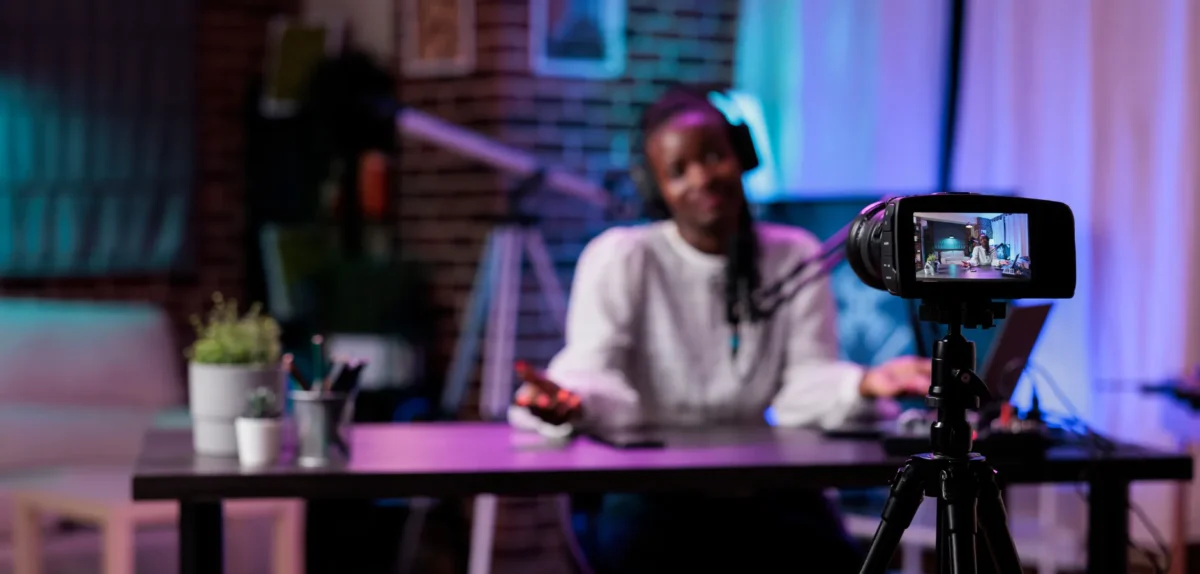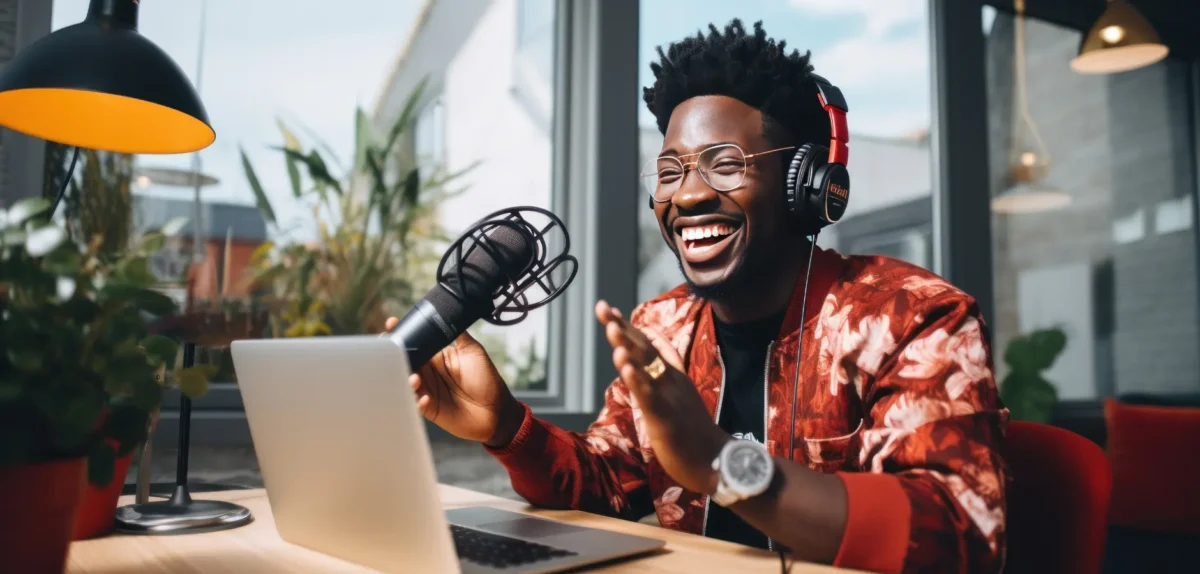The global influencer marketing industry is exploding in 2025—with a projected 36 percent surge leaving traditional advertising channels scrambling to keep up. With more than three out of four marketers now allocating dedicated budgets to creator partnerships and social media influencers, one thing is clear: influencer marketing has moved from an optional strategy to an essential business driver.
Behind this meteoric rise is a notable shift in how brands approach creators. As Lindsey Gamble notes, “What worked yesterday won’t deliver results tomorrow.” The industry is rapidly embracing performance-driven partnerships, prioritizing measurable return on investment (ROI) marketing, while consumers increasingly demand authentic connections over polished perfection. Meanwhile, AI-powered influencer ROI tracking tools are reshaping everything from creator discovery to social media influencer strategy.
Get the full scoop on these influencer marketing trends for 2025 in this expert-backed guide, which reveals how to optimize creator partnerships and increase ROI with influencers to stay ahead of the competition.
Meet the experts behind these 2025 influencer marketing trends
We’ve gathered insights from leading industry experts to bring you the most accurate and actionable trends for influencer marketing in 2025. Their combined expertise spans platforms, strategies, and industry verticals.
- Olivia Savage is a Senior Marketing Strategist and expert in Creator Relations at impact.com.

- Jeff Melton is the Senior Director of Global Creator Community and Consulting at impact.com.

- Marie Montano is the Senior Manager of Creator Relations at impact.com.

- Caroline Hindman is the Senior Manager of Creator Services at impact.com.

- Jake Leganski is the Vice President of Affiliate at Dreamday, the award-winning communications and performance PR Agency.

- Kristina Nolan is the Vice President of Media Services at DMi Partners, a full-service digital agency focused on driving growth for its clients.

- Megan Rolfe is the Senior Influencer Marketing Manager at Acceleration Partners, the world’s largest and first-to-market Partnership and Marketing Agency.

- Kelsey Abell is the Vice President of Influencer Marketing at Tinuiti, the largest independent full-funnel performance marketing agency in the U.S.

- Bailee Switzer is the Director of Affiliate at Tinuiti.

- Lindsey Gamble is an influencer marketing consultant and Creator Economy expert with a wide digital presence across LinkedIn, Instagram, X, and Threads.

- Tina Angelina is a UGC creator and creative strategist. Her social media presence spans TikTok, Instagram, and YouTube with a pulse on authentic storytelling and trends.

Now, let’s dive into the top influencer marketing trends these experts predict will shape the industry in 2025.
Performance-driven creator partnerships transform ROI marketing
One of the most defining shifts in 2025 is the move toward performance-based influencer partnerships. “Brands are reallocating their budgets to favor performance-driven models, focusing on commissions rather than flat fees,” explains Jake Leganski. This reflects a broader industry trend in which measurable impact has become the new currency of influencer marketing.
Kelsey Abell and Bailee Switzer explain the move toward performance-based models. “With marketing teams under pressure to prove ROI, many brands are transitioning to performance-driven influencer partnerships.” This shift allows brands to tie every dollar spent directly to measurable results.
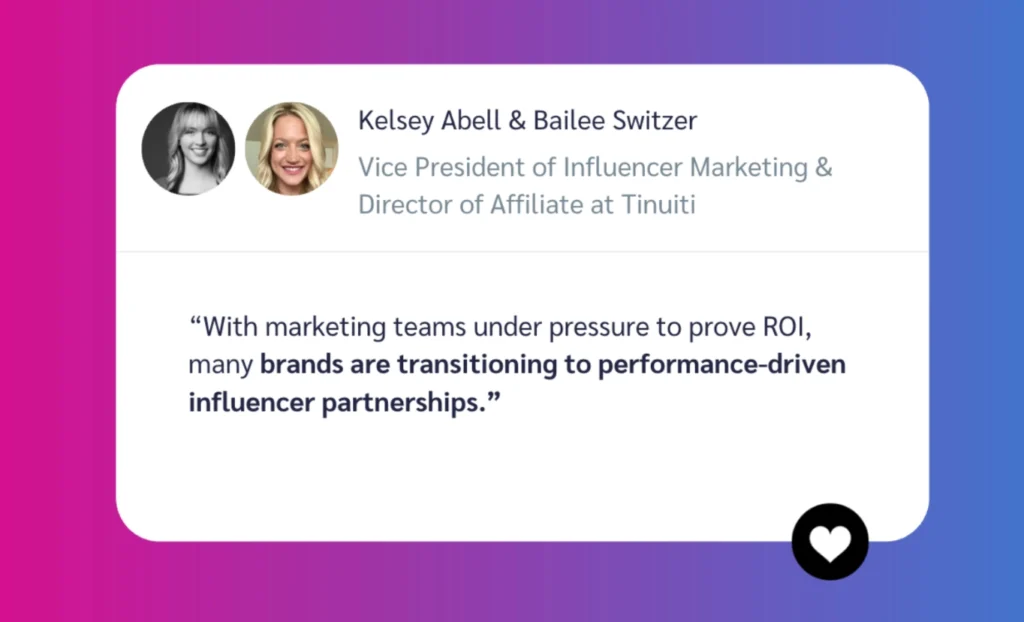
Kelsey Abell and Bailee Switzer emphasize the value of performance-driven creator partnerships to prove ROI and justify marketing budgets.
As a result, influencer marketing is increasingly shifting away from building general brand awareness to driving measurable conversions and sales.
The shift from awareness to conversion
Traditional influencer marketing focused primarily on awareness metrics—views, likes, and follows. Today’s forward-thinking brands are pivoting toward what Caroline Hindman describes as “the convergence of creator and affiliate strategies to create campaigns targeting customers at every point in their journey: from awareness through conversion.”

Caroline Hindman highlights a crucial insight into merging creator and affiliate strategies: focusing on supporting the customer at every stage of their brand journey.
This change represents a maturation of the influencer marketing industry, moving beyond surface-level metrics to focus on business outcomes that directly impact the bottom line.
Hybrid compensation models explained
The shift toward performance is reshaping how creators get paid. Rather than relying solely on upfront payments, brands are implementing hybrid models that align creator incentives with business goals:
- Base fee plus commission: A smaller guaranteed payment combined with performance-based commissions
- Tiered commission rates: Increasing percentages as sales volume grows
- Multi-action compensation: Rewards for various conversion activities beyond just sales
- Long-term revenue sharing: Ongoing commissions for customer lifetime value
Olivia Savage notes these “hybrid compensation models that combine smaller upfront payments with affiliate commissions enable creators and brands to win.” The approach provides creators with immediate compensation, while incentivizing ongoing performance, creating a sustainable partnership model.

Olivia Savage breaks down hybrid compensation models in a nutshell.
Measuring what matters: Beyond likes and followers
With the focus on creator partnerships moving toward performance, brands are implementing more sophisticated measurement approaches. Jeff Melton explains how “marketers are using advanced analytics to reward creators for actions beyond last-click sales. For example, compensating creators for consistently accelerating conversation windows.”
Key performance indicators now include:
- Conversion rates across multiple touchpoints
- Average order value from creator-driven traffic
- Customer acquisition cost compared to other channels
- Return on ad spend for amplified creator content
Success spotlight: Notta, a leading AI notetaker, introduced flexible compensation types to its affiliate program, including a hybrid model for long-term strategic partners. By leveraging campaign performance insights, the team optimized their program, achieving a tenfold increase in monthly revenue.
As brands focus on measurable results, they’re discovering that authenticity isn’t just a values statement—it’s the essential foundation that makes performance-driven partnerships successful.
Creators as sales drivers: The new commerce engine
The creators’ role has transformed from mere content producers to powerful sales channels. This new role represents one of the most significant shifts in influencer marketing partnerships for 2025.
Branded storefronts: Expert curation for influencer marketing
Branded storefronts are emerging as a game-changing approach, offering customized, brand-specific digital pages where creators showcase curated product selections. This approach capitalizes on the trust creators have built with their audiences while streamlining the path to purchase.
Megan Rolfe explains that these storefronts “ensure a steady stream of content that feels organic, resonates with audiences, and keeps the algorithm working in their favor,” addressing the growing need for dynamic, engaging content while driving conversions.
The branded storefront trend reflects how Melton sees the industry heading—toward solutions that “take full advantage of the convergence between creators and affiliates, offering innovative technologies to further optimize performance and drive conversions.”
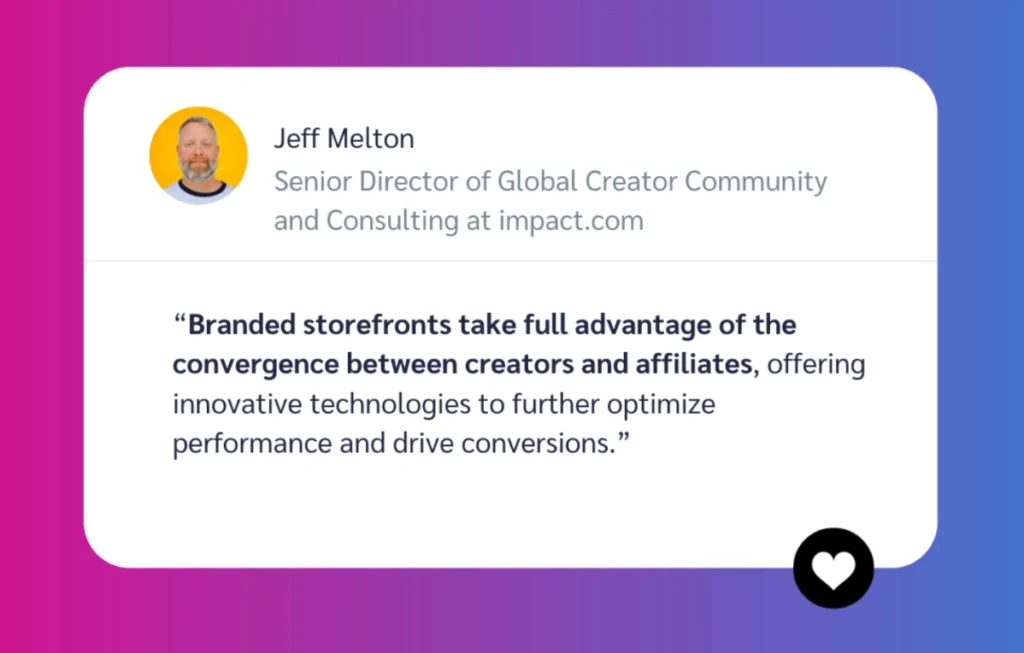
Jeff Melton explores the role of branded storefronts and their significance in boosting conversions.
Platform integration transforms purchase journey
The shopping experience is becoming increasingly frictionless as platforms like TikTok Shop and YouTube Shopping evolve. Kristina Nolan highlights how “creators are no longer just brand advocates—they’ve become true sales drivers,” with integrated checkout processes making it easier for audiences to purchase without leaving their preferred platform.
Key integration developments include:
- One-click purchasing from creator content
- Creator-specific discount codes applied automatically
- Seamless inventory management across creator storefronts
- Real-time sales analytics for brands and creators
From content creator to commerce partner
As creators become more commercially sophisticated, their approach to content is maturing. Marie Montano observes brands are increasingly “creating their own dedicated creator-focused pages and storefronts and asking for more content to be posted to their dedicated storefront pages.”
This shift benefits all stakeholders:
- For brands: Direct attribution and higher conversion rates
- For creators: More sustainable revenue streams
- For consumers: Curated shopping experiences from trusted voices
The transformation toward creator commerce is pushing brands to develop more comprehensive strategies that blend content creation with sales functionality—a trend that naturally connects to the growing importance of community building.
Building stronger communities for sustainable success
As the influencer marketing environment becomes increasingly crowded, brands recognize that one-off campaign partnerships deliver diminishing returns. The most forward-thinking companies instead invest in what Rolfe describes as “community building” approaches that foster deeper, more authentic connections over time.
Community building to boost ROI marketing
“Brands are moving beyond one-and-done campaigns and investing in long-term relationships with smaller creators,” Rolfe explains. This approach fosters deeper connections and creates a sense of authenticity that resonates with audiences, driving sustained engagement rather than temporary spikes.

Megan Rolfe sheds light on a key influencer marketing trend for 2025: brands prioritizing long-term collaborations with nano and micro-creators to drive lasting impact.
Hindman adds, “Community building is an emerging trend for brands and agencies looking to support their creator and affiliate partners. We’re also seeing more brands lean on nano- and micro-creators to support lower-funnel campaign strategies.”
Nano and micro-influencer strategy
Compelling data back the enthusiasm for smaller-scale creators:
- Nano-influencers (less than 15k followers) generate higher engagement rates than brand posts
- Micro-influencers (15k-75k followers) connect with nearly half of audiences
These findings explain why brands increasingly divide larger budgets among multiple smaller creators rather than investing everything in a single celebrity partnership.
Values alignment drives performance
With smaller influencers becoming more prominent, Tina Angelina highlights the importance of connecting with niche audiences. “Community-first marketing ensures that the message aligns with an audience’s values, building loyalty over time.”
Melton reinforces this concept, noting how brands are blending affiliate and creator efforts to “build a tiered system of ambassadors and affiliates who share meaningful content across multiple touchpoints.”
Communities also offer budget advantages, according to Leganski: “Finding niche audiences with shared interests is an easier and more affordable way to reach your target group, especially when done through creators.”
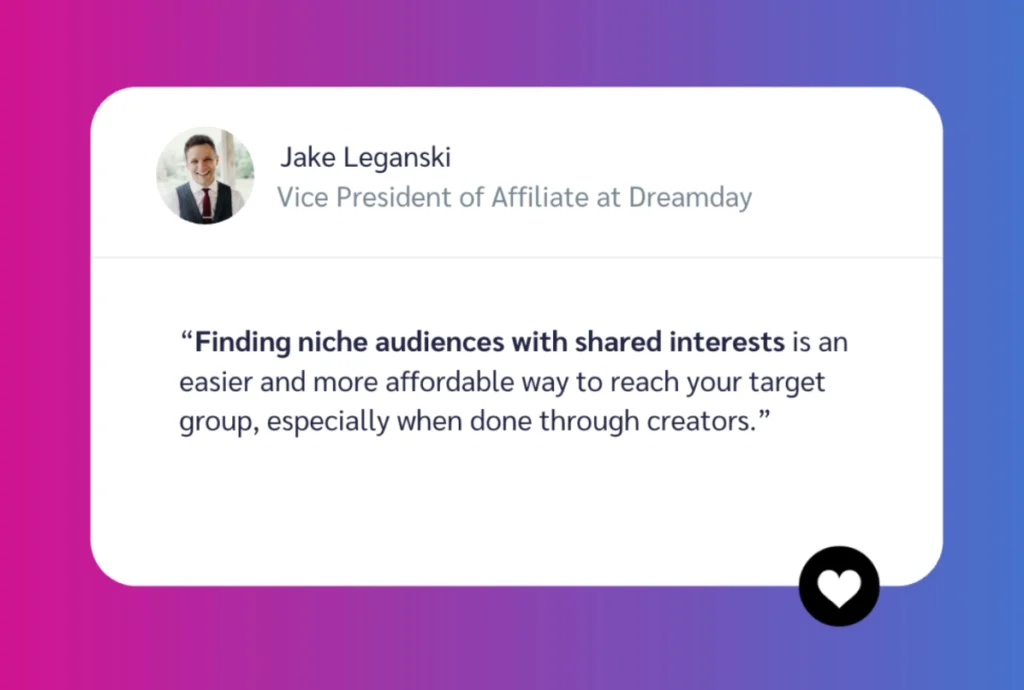
Jake Leganski explores the power of community building by focusing on niche audiences and shared interests. He highlights how these connections can be effectively harnessed through collaboration with the right creators.
This community-centered approach naturally complements the growing emphasis on authenticity that dominates today’s influencer landscape.
Authenticity in influencer marketing: the new currency for content creators
The demand for authenticity is reshaping creator content and brand expectations. As consumers become increasingly savvy about recognizing sponsored content, the value of genuine, relatable messaging has never been higher.
Authenticity over perfection: the rise of relatable content
Angelina explains that “audiences want creators to speak directly to the camera as if they were FaceTiming a friend. Gone are the days of overly polished, edited videos.”
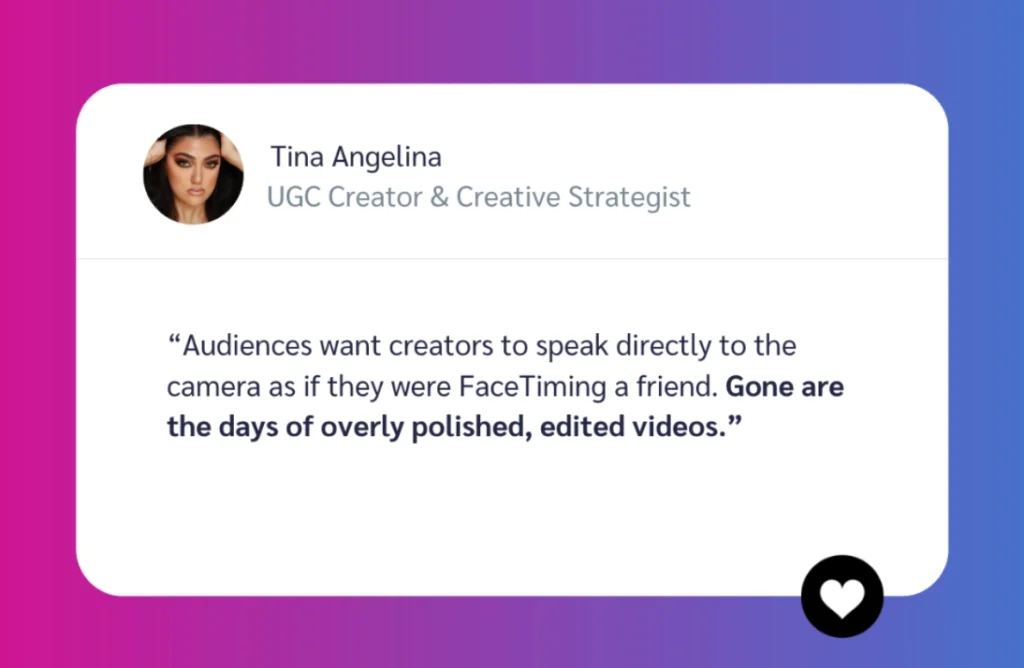
Tina Angelina highlights a greater emphasis on authenticity in influencer marketing for 2025.
This preference is backed by data: creators who showcase unfiltered, authentic content experience stronger engagement rates due to their personal connection with their audiences. Rolfe adds that “raw, unscripted storytelling is quickly becoming one of the most powerful ways to build trust and emotional resonance with consumers.”
How brands are adapting creator content expectations
Brands are adjusting their content requirements in response to this authenticity trend:
- Moving away from tightly scripted deliverables toward conversational guidelines
- Encouraging creators to share authentic experiences rather than reading talking points
- Prioritizing relatability over production quality
- Seeking creative input from creators earlier in the campaign development process
Tina describes how brands now specifically request organic, natural content, “favoring talking-head videos where creators use and narrate their experiences with products.” This shift reflects a commitment to showing rather than telling, bringing audiences closer to the brand’s message.
Balancing brand guidelines with creator voice
While authenticity is key, successful campaigns still require alignment between brand identity and creator voice. Most effective partnerships now include:
- Collaborative content planning sessions
- Brand education about creator audience expectations
- Clear parameters with creative freedom
- Ongoing optimization based on audience response
Montano observes that while aspirational content remains valuable, “it’s becoming less about ‘look at me and how much I have’ and more about ‘look how real I am’ with ‘come along with me on a real day’ type of content.”

Audiences crave relatability: Marie Montano delves into the authentic content users are looking for as the future of influencer marketing continues to evolve.
Savage predicts this will intensify, noting that “valid criticisms of influencer culture will push successful creators to continue to be innovative and unique when partnering with brands, to maintain their authenticity, credibility, and capture new audiences’ attention.”
The unstoppable rise of user-generated content
As brands seek both authenticity and scale, user-generated content (UGC) has emerged as a powerful solution, especially on fast-paced platforms like TikTok.
Leveraging UGC for influencer ROI
Nolan observes that “TikTok’s algorithm rewards brands that consistently deliver fresh and engaging material. UGC enables them to meet this demand while maintaining a sense of authenticity.”
With traditional influencer rates climbing, brands are adapting their approaches. Abell and Switzer explain: “Brands are turning to nano- and micro-creators to produce content that performs just as well—if not better—than traditional influencer posts.”
From influencer content to UGC campaigns
The UGC approach differs from traditional influencer marketing in several key ways:
- Focus on content quality rather than creator follower count
- Emphasis on convertible formats over awareness-building content
- Higher volume of assets produced at lower individual costs
- Greater flexibility for repurposing across multiple channels
Leganski highlights a particular advantage of UGC creators, noting they “specialize in content tailored to convert audiences. From engaging hooks to strong CTAs, UGC creators know how to connect with viewers.”
UGC + affiliate = performance powerhouse
The integration of UGC with affiliate marketing creates a particularly powerful combination. Savage explains how “performance-tracked UGC campaigns help measure direct sales impact, offering both scalability and clarity.”
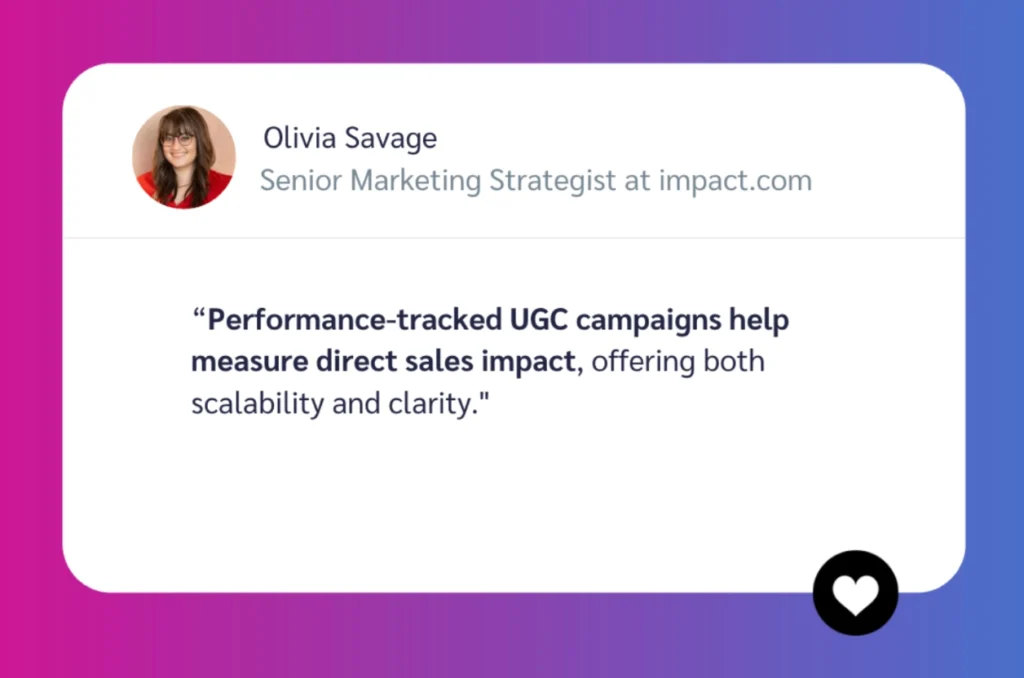
According to Olivia Savage, effective UGC campaigns rely on performance-driven data to accurately measure its sales impact.
This hybrid approach enables brands to:
- Track which content formats drive the highest conversions
- Identify the most effective creator partners based on performance
- Scale successful content through paid amplification
- Optimize messaging based on conversion data
Resident, a top direct-to-consumer mattress and bedding brand, found success connecting creators to their affiliate channels using paid ads. This strategy allowed them to engage customers at every stage of the buyer’s journey. By leveraging impact.com/creator, the team built a UGC library filled with authentic content that outperformed traditional ads. The result? Resident doubled the value of each post and video, driving significant profitability and growth.
The UGC revolution demonstrates how content creation is becoming increasingly democratized while simultaneously becoming more performance-focused—a pattern that AI tools are accelerating.
AI: An influencer marketing streamliner
AI is transforming every aspect of influencer marketing, from campaign planning to execution and optimization. Nolan highlights this trend, explaining, “AI is revolutionizing the way brands predict trends, identify creators, and design campaigns. Tools powered by AI can now analyze target audience sentiment and engagement metrics to match creators with the right opportunities.”

AI-driven processes: Kristina Nolan explores the transformative role of AI in shaping the future of influencer marketing, offering insights into what lies ahead for 2025 and beyond.
AI-powered campaign optimization
Marketers and creators are leveraging artificial intelligence to enhance multiple aspects of their partnerships:
Creator discovery and matching
AI tools are fundamentally changing how brands find and select creator partners:
- Predictive analysis identifies rising creators before they reach peak rates
- Sentiment analysis evaluates creator-audience relationships beyond basic metrics
- Audience overlap detection prevents inefficient creator investment
- Brand safety scoring reduces partnership risks
These capabilities enable more precise targeting and more efficient budget allocation, particularly for performance-focused campaigns.
Balancing automation with authenticity
Montano sees AI going beyond campaign targeting: “We’re seeing the rise of AI-generated influencers and tools that assist creators with enhancing their content, streamlining workflows, and even developing captions.”
However, Montano cautions against over-reliance on these technologies, stressing the importance of maintaining authenticity as AI evolves. The most successful brands find the sweet spot between technological efficiency and human connection, using AI to enhance rather than replace the creator’s unique voice.
This balanced approach recognizes that while AI can optimize processes, the human element remains essential to building long-term relationships with audiences—a principle that extends to emerging channel strategies.
Emerging channels expand creator reach
As the influencer space matures, creators are diversifying their presence beyond algorithm-dependent social platforms. This expansion reflects both the need for greater audience control and the evolution of where and how consumers engage with content.
Newsletters elevate brand conversions through creator partnerships
With the rise of platforms like Substack and Beehiiv, creators can now deliver highly targeted, opt-in content to engaged audiences. Gamble notes that “unlike algorithm-based platforms, newsletters allow creators and brands to connect directly with followers, building trust over time.”

Creator Economy Expert Lindsey Gamble highlights the power of newsletters, emphasizing how they enable brands and creators to connect directly with their audiences while bypassing platform algorithms.
This trend is especially prevalent among creators in niche industries. As Gamble explains, “Creators are using newsletters to compile affiliate links, creating a one-stop shop for audiences to discover and purchase recommended products.”
Building direct audience relationships
The newsletter approach offers several strategic advantages:
- Direct access to audiences without platform algorithm interference
- Higher-intent audience members who actively opt in
- Ability to combine content, commerce, and community
- Detailed performance metrics for optimization
For brands, newsletter collaborations represent a high-intent channel with engaged audiences who have demonstrated interest in creator recommendations.
LinkedIn: The evolving B2B influencer marketing hub
While consumer-focused platforms dominate influencer conversations, LinkedIn is emerging as a powerful channel for B2B influencer marketing. Gamble explains that with “its investment in creators and new features like short-form videos and Thought Leader Ads, LinkedIn is poised to dominate the business-to-business influencer marketing space.”
Rolfe supports this observation, noting that “LinkedIn is becoming more prominent for B2B influencer marketing, and with other emerging platforms, could challenge TikTok’s dominance in the space over time.”
This platform diversification illustrates how influencer marketing continues to expand beyond its original channels, creating a new opportunity for brands and creators to connect with audiences in more meaningful ways.
FAQs
Creator and affiliate marketing are converging into a comprehensive, full-funnel strategy, enabling brands to engage customers at every stage—from awareness to conversion. Authenticity has become a cornerstone of success, as audiences increasingly prefer genuine content above overly polished productions. User-generated content remains a powerful tool for building brand awareness, and when combined with affiliate marketing, it creates a highly effective performance-driven strategy. Additionally, LinkedIn is gaining traction as a key platform for B2B marketing and may soon emerge as a strong competitor to TikTok in this space.
A major trend in influencer marketing is the move toward performance-based partnerships and greater transparency in measuring partner success. Brands are learning to strike a balance between maintaining their guidelines and allowing creators to express their authentic voice, resulting in genuine content that still aligns with the brand’s identity. Meanwhile, creators are finding new ways to bypass platform algorithms, with newsletters emerging as a key strategy. By curating their top affiliate links, creators can connect directly with their audiences and drive conversions more effectively.
AI-driven campaigns are transforming the marketing industry in 2025 and are set to play an even bigger role in the future. Marketers are leveraging AI to manage campaigns, streamline creator discovery, predict emerging trends, and even craft captions. However, brands must strike a balance between innovation and authenticity—using AI not to overshadow a creator’s unique voice, but to amplify it.
Optimize your creator partnerships in 2025: Maximizing ROI marketing with performance-driven strategies
As brands plan their strategies for 2025, adapting to these trends will be essential for competitive advantage. The evolution toward performance-driven partnerships offers an unprecedented opportunity for brands to maximize ROI, while authenticity remains the foundation for meaningful audience connections.
By embracing both technological advancements like AI and human-centered approaches like community building, brands can create more effective, measurable influencer programs. The integration of commerce capabilities further transforms creators from awareness channels into direct sales drivers.
impact.com enables brands to streamline these complex processes, offering tools to:
- Implement hybrid compensation models that align creator incentives with brand goals
- Connect with authentic micro-influencers using data-driven matching
- Build and manage branded storefronts that drive measurable results
- Track and optimize performance across the entire creator journey
Now’s the time to integrate these trends into your influencer strategy, leveraging both innovative technology and authentic creator relationships to drive sustainable growth.
Ready to get started with impact.com? Request a demo today.
Additional resources:
- https://impact.com/influencer/brand-creator-collaboration/
- https://impact.com/podcasts/episodes/building-scalable-creator-partnerships-natasha-scholnick/
- https://impact.com/partnerships/ultimate-guide-to-influencer-marketing/
- https://impact.com/affiliate/affiliate-and-influencer-strategies-integrations/
- https://impact.com/lp/convergence-whitepaper/
- https://impact.com/influencer/how-ai-automation-and-authenticity-are-changing-influencer-marketing/



